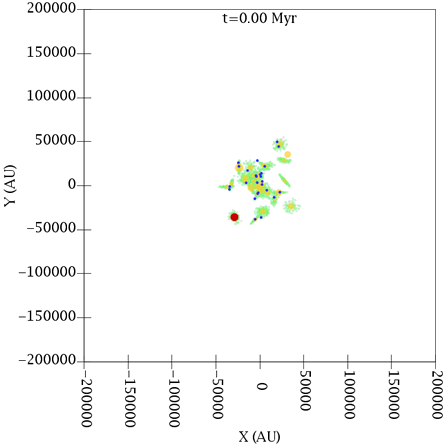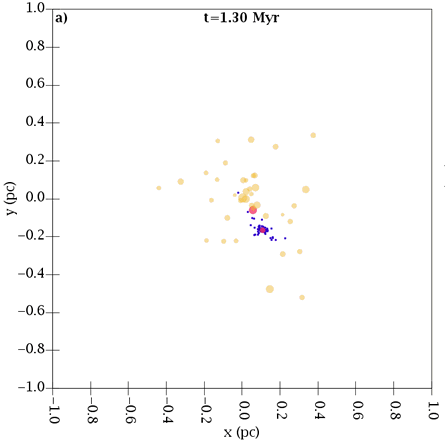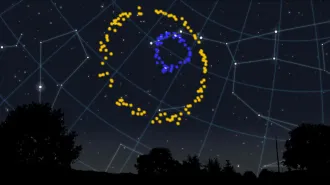View a video Oort cloud formation
When it comes to adoption, the sun may have it all over celeb parent Angelina Jolie. Most of the hundreds of billions of small fry in the outermost reaches of the solar system — comets in a vast reservoir called the Oort cloud — might have been born around other stars and only later moved to the sun, new computer simulations suggest.
If the findings are correct, the sun may have adopted such familiar comets as Halley, Hale-Bopp and Kohoutek from other stars. These comets are émigrés from the Oort cloud that have visited the inner solar system.
“It’s just so cool to think that you could almost reach out and touch something that was formed around another star,” says theorist Hal Levison of the Southwest Research Institute in Boulder, Colo. The finding, which Levison and his colleagues describe online June 10 in Science, also suggests that comets in the solar system may have diverse chemical compositions that reflect their formation around different stars.
Other researchers, while noting that the study is intriguing and carefully done, say they have qualms about the results because so little is known about the early history of the sun and about the Oort cloud’s current population. Responding to the study team’s assertion that more than 90 percent of Oort cloud comets were born around other stars, “I would answer ‘hold your horses,’ because I don’t think anything has been proven yet,” says planetary scientist Hans Rickman of the Uppsala Astronomical Observatory in Sweden, who was not involved in the study.
Levison and his colleagues began their study by pondering the origin of comets in the solar system’s Oort cloud, an enormous spherical reservoir thought to mark the outer edge of the solar system. The cloud extends nearly halfway to the sun’s nearest neighbor star. Most researchers had assumed that the cloud arose exclusively from material in the disk of gas, dust and ice that surrounded the young sun.
In one current model of comet origins, Oort cloud comets are considered native to the solar system and thought to have formed closer to the sun than they now reside. In that scenario, the outer planets spread apart over time into a region containing icy leftovers from the planet-forming process. That migration pushed some of the icy debris even farther out in the solar system, and some of that debris ultimately became the Oort cloud. This model, however, can explain a population of Oort cloud comets less than one-tenth as abundant as many researchers believe the reservoir actually contains, Levison says. This large discrepancy led his team to explore an extrasolar origin for most of the Oort cloud residents.
The new simulations show that during the sun’s first 3 million to 5 million years, it could have snared comets that initially belonged to other members of its birth cluster of stars. The capture could have happened in either, or both, of two ways.
In the first, more common scenario, close gravitational encounters between stars could have stripped comets from their birth stars. Those comets became free floaters within the cluster. Then, when the cluster’s most massive, shortest-lived stars emitted strong winds or exploded in supernovas, the clusters broke apart. Comets that happened to fly outward in the same direction as a particular star could have become bound to that star.
A second scenario suggests that neighboring stars of different sizes could have swapped comets between them, forming a cloud around the larger star, the simulations show.
The model accounts for the population of bodies that theorists believe actually lies in the reservoir, Levison says.
Some researchers not associated with the study cite caveats, though. Michael Mumma of NASA’s Goddard Space Flight Center in Greenbelt, Md., notes that because the mass and other properties of stars in the sun’s birth cluster are unknown, it’s unclear if the simulations performed by Levison’s team accurately reflect conditions that prevailed during the sun’s formative years.
It’s also unclear how many comets lie in the solar system’s Oort cloud today, Rickman says, and how easy it is to populate this reservoir with objects from the solar system. If it’s more efficient for native comets to join the cloud than previously thought, the apparent discrepancy in the number of Oort cloud comets that prompted the new study may not really exist, he says.
Still, “this is a beautiful piece of work, and I’m quite thrilled to see what comes out eventually,” Rickman says.

Free-floating comets (green and blue dots) move randomly within a young cluster of stars (orange and red) at the beginning of this computer simulation. When supernova explosions and strong stellar winds break apart the cluster, the comets (blue) traveling in the same direction as the red star become members of that star’s Oort cloud. Credit: Courtesy of H. Levison

Two nearby stars of different sizes (red dots) have a gravitational encounter. The larger star grabs comets (blue) from the smaller star, creating an Oort cloud. Credit: Courtesy of H. Levison







